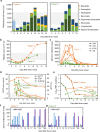A novel nairovirus associated with acute febrile illness in Hokkaido, Japan
- PMID: 34545081
- PMCID: PMC8452618
- DOI: 10.1038/s41467-021-25857-0
A novel nairovirus associated with acute febrile illness in Hokkaido, Japan
Abstract
The increasing burden of tick-borne orthonairovirus infections, such as Crimean-Congo hemorrhagic fever, is becoming a global concern for public health. In the present study, we identify a novel orthonairovirus, designated Yezo virus (YEZV), from two patients showing acute febrile illness with thrombocytopenia and leukopenia after tick bite in Hokkaido, Japan, in 2019 and 2020, respectively. YEZV is phylogenetically grouped with Sulina virus detected in Ixodes ricinus ticks in Romania. YEZV infection has been confirmed in seven patients from 2014-2020, four of whom were co-infected with Borrelia spp. Antibodies to YEZV are found in wild deer and raccoons, and YEZV RNAs have been detected in ticks from Hokkaido. In this work, we demonstrate that YEZV is highly likely to be the causative pathogen of febrile illness, representing the first report of an endemic infection associated with an orthonairovirus potentially transmitted by ticks in Japan.
© 2021. The Author(s).
Conflict of interest statement
The authors declare no competing interests.
Figures



References
Publication types
MeSH terms
Substances
Grants and funding
LinkOut - more resources
Full Text Sources
Medical
Miscellaneous

